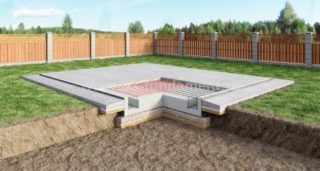The foundation base is designed to evenly distribute the load from the above-installed structures along the soil mass on which construction is being carried out. The need to lay the foundation is due to the fact that in addition to the movement of soil, the weight of the structure itself and changing climatic conditions also affect the foundation of each house during operation. To withstand these forces, a building needs a solid and solid foundation that can accept and evenly distribute the expected loads. One of the parameters that determine the reliability and durability of buildings is the depth of the foundations, which can be buried, shallow and deeply buried. The latter are used, as a rule, in the construction of industrial or high-rise buildings and their calculation is highly complex.
- The main factors affecting the depth of the foundation
- The depth of soil freezing
- Minimum foundation depth
- Arrangement of a stepped foundation
- Influence of neighboring buildings and structures on the depth of laying a new foundation
- Arrangement of adjacent foundations
- Influence of utilities and underground canals on the depth of foundation laying
- Influence of the method of carrying out work on the depth of laying the foundation
The main factors affecting the depth of the foundation

In order to correctly calculate the depth of the foundation, it is necessary to take into account:
- depth of groundwater;
- stratal stratification of soils;
- the depth of soil freezing;
- the content of aggressive components in the composition of the soil;
- the brand of the material used.
The depth of the foundation depends on the location of the new home: a row building or a detached building.
The depth of soil freezing
When laying any foundation, it must be borne in mind that the soil in different regions has different density and water saturation. You can find out about these features of the soil from the owners of neighboring buildings.
Minimum foundation depth

The foundation foundation should be laid below the groundwater level. Otherwise, when the soil swells due to freezing, the foundation may collapse, because the force of seasonal soil movements can be from 10 to 15 t / m2. At the same time, the unevenness of the soil swelling in different parts of the site can cause a skew of the pillow, which leads to the appearance of cracks and, ultimately, to its destruction.
The calculation of the foundation depth is carried out according to the formulaHp = Mt * m * Hhwhere:
- Hh - depth of soil freezing;
- Mt - coefficient of influence of heat of the outer walls of the building (Mt = 0,7-1,0);
- m - coefficient of building operating conditions (m = 1,1).
Theoretically, the minimum foundation depth is:
- 0.5 m - if there is no danger of soil freezing, and the groundwater does not approach the base of the foundation cushion by more than 2 m;
- 0.8 m - for non-freezing soils (sand, gravel, etc.);
- 0.8 m - for freezing soils, provided that the groundwater does not approach the base of the foundation by more than 2 m;
- 1.0 m - for freezing soils.
Average statistical calculations show that the depth of the foundations should be at least 0.9 m.However, taking into account the climatic conditions of most regions of Russia, experts advise placing the base of the foundation at a depth of 1.1 m, since soil swelling is possible during severe frosts, typical for many regions of Russia.
Before calculating the depth of the foundation, you need to pay attention to whether the basements will be heated. If so, the depth of the trench for the sole of the base is reduced by 20-30%; if not, it is better to increase it by 10%. In addition, it is allowed to reduce the depth of laying the foundation under the inner walls of the structure being erected.
Arrangement of a stepped foundation
When different elements of the foundation must have different depths, for example, under external and internal walls, etc., the transition from one depth of the foundation to another should be smooth.
If the foundation base is made of standard concrete blocks, the length of the steps (Ly), with the help of which a smooth transition from one mark to another is carried out, must satisfy the conditions of the relation Ly / hy ≤ 0.5 m.
Influence of neighboring buildings and structures on the depth of laying a new foundation
In addition to the amount of freezing of the soil and the level of occurrence of groundwater, the location of the foundation significantly affects the depth of laying the foundation:
- foundations of neighboring, especially adjoining buildings;
- engineering communications and an underground channel;
- basement room.
Arrangement of adjacent foundations
where 1, 2, 3 - options for deepening a newly constructed building.
When building a new house next to existing buildings, it is most advisable to use option 2, in which the foundations of adjacent buildings are located at the same level. But even in this case, in order to avoid additional impact on the base of the existing house, it is recommended to equip a dividing tongue.
It is not recommended to use options 1 and 3 for the following reasons:
- When the foundation is deepened above the adjacent structure (option 1) due to additional lateral pressure, there is a risk of additional uneven settlement. To avoid this phenomenon, the newly laid foundation must be moved away from the existing building at a distance L, the value of which is determined from the ratio ∆H / L ≤ tgφ.
- If the supporting surface of the building under construction is located deeper than the existing building (option 3), it is possible to uplift the soil under the previously laid foundation during the work.
Influence of utilities and underground canals on the depth of foundation laying
Underground channels used in the laying of utilities have predetermined elevations. In this case, it is necessary that the base of the new foundation is located below the underground channel by at least 0.2 m.
In addition, it is necessary to exclude bulging and freezing of the soil from the side of the basement during work. This will be helped by fulfilling the condition dmin ≥ 0.5 dfn.
Influence of the method of carrying out work on the depth of laying the foundation
The depth of the foundation of a building under construction predetermines the choice of the way in which it is supposed to carry out earthworks. In turn, the chosen method of carrying out the work also has a significant impact on the depth of its laying. This is due to the fact that very often the need to use the maximum number of prefabricated mechanized works does not always coincide with the capabilities of the construction organization.
The geological section of the construction site presented in the diagram determines the methods of deepening the foundation, depending on the different methods of performing the work.
- In the first variant, the soil is silty sand, which belongs to the category of soft soils. As a rule, this requires the arrangement of a flexible foundation of a sufficiently large size, which requires a minimum amount of excavation from the builders.
- In the second variant, the base of the building is buried in a layer of loam, which allows it to be designed with minimal dimensions. However, at the same time, the construction organization will need to dig a deep foundation pit and additionally strengthen its walls. Arrangement of artificial drainage will also be useful in this case.
- The third option involves the use of a pile foundation, which is characterized by the minimum volume of earthworks and concrete pouring operations. But in this case, additional technological methods and the availability of special equipment for the installation of piles will be required.
The final decision on the choice of one or another option for arranging the foundation is carried out by the joint efforts of designers, engineers of the construction organization and the customer. The accepted option, in any case, should be based on a deep analysis of the technical and economic characteristics of the future structure - only in this case it is possible to guarantee the durability and reliability of the building being erected.








